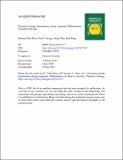Files in this item
Potassium isotope fractionation during magmatic differentiation of basalt to rhyolite
Item metadata
| dc.contributor.author | Tuller-Ross, Brenna | |
| dc.contributor.author | Savage, Paul S. | |
| dc.contributor.author | Chen, Heng | |
| dc.contributor.author | Wang, Kun | |
| dc.date.accessioned | 2020-07-10T23:34:24Z | |
| dc.date.available | 2020-07-10T23:34:24Z | |
| dc.date.issued | 2019-07-11 | |
| dc.identifier | 259625281 | |
| dc.identifier | fa25dd97-b780-405f-afda-a027d2511fa6 | |
| dc.identifier | 85069567080 | |
| dc.identifier | 000501715700004 | |
| dc.identifier.citation | Tuller-Ross , B , Savage , P S , Chen , H & Wang , K 2019 , ' Potassium isotope fractionation during magmatic differentiation of basalt to rhyolite ' , Chemical Geology , vol. In press . https://doi.org/10.1016/j.chemgeo.2019.07.017 | en |
| dc.identifier.issn | 0009-2541 | |
| dc.identifier.other | ORCID: /0000-0001-8464-0264/work/64034609 | |
| dc.identifier.uri | https://hdl.handle.net/10023/20234 | |
| dc.description | Authors thank the McDonnell Center for the Space Sciences and the UK National Environment Research Council for their support. Funding for this work was provided in part by NERC grant NE/R002134/1. | en |
| dc.description.abstract | High-temperature equilibrium and kinetic stable isotope fractionation during partial melting, fractional crystallization, and other igneous differentiation processes has been observed in many isotope systems, but due to the relative nascence of high-precision analytical capabilities for K, it is still unclear whether igneous processes induce systematic and resolvable K isotope fractionation. In this study, we look to the natural laboratory of Hekla volcano in Iceland to investigate the behavior of K isotopes during magmatic differentiation of basalt to rhyolite. Using a novel MC-ICP-MS method, we analyzed 24 geochemically diverse samples from Hekla, including 7 basalts, 8 basaltic andesites, 3 andesites, 4 dacites, and 2 rhyolites, along with 2 additional samples from Burfell, Iceland, for comparison (1 basalt and 1 trachyte). We observed extremely limited variation of 41K/39K ratios throughout our suite of samples, which is not resolvable within the best current analytical uncertainty. The average value of all samples is δ41KNIST SRM3141a = −0.46 ± 0.07‰ (2sd). This value agrees with the Bulk Silicate Earth value previously defined by average global oceanic basalts in literature. The lack of variation throughout this suite of samples from a single volcano system indicates that K does not fractionate during magmatic differentiation (of basalt to rhyolite) through processes such as partial melting and fractional crystallization. This conclusion is important to the estimation of the Bulk Silicate Earth K isotope composition, to placing a more robust estimate on the composition bulk continental crust, and to fostering a better understanding of the behavior of K isotopes during differentiation of the terrestrial planets. | |
| dc.format.extent | 6891784 | |
| dc.language.iso | eng | |
| dc.relation.ispartof | Chemical Geology | en |
| dc.subject | Potassium isotopes | en |
| dc.subject | MC-ICP-MS | en |
| dc.subject | Hekla | en |
| dc.subject | Magmatic differentiation | en |
| dc.subject | Isotope fractionation | en |
| dc.subject | GE Environmental Sciences | en |
| dc.subject | QE Geology | en |
| dc.subject | QD Chemistry | en |
| dc.subject | NDAS | en |
| dc.subject.lcc | GE | en |
| dc.subject.lcc | QE | en |
| dc.subject.lcc | QD | en |
| dc.title | Potassium isotope fractionation during magmatic differentiation of basalt to rhyolite | en |
| dc.type | Journal article | en |
| dc.contributor.sponsor | NERC | en |
| dc.contributor.institution | University of St Andrews. School of Earth & Environmental Sciences | en |
| dc.contributor.institution | University of St Andrews. St Andrews Centre for Exoplanet Science | en |
| dc.contributor.institution | University of St Andrews. St Andrews Isotope Geochemistry | en |
| dc.identifier.doi | 10.1016/j.chemgeo.2019.07.017 | |
| dc.description.status | Peer reviewed | en |
| dc.date.embargoedUntil | 2020-07-11 | |
| dc.identifier.grantnumber | NSF | en |
This item appears in the following Collection(s)
Items in the St Andrews Research Repository are protected by copyright, with all rights reserved, unless otherwise indicated.

